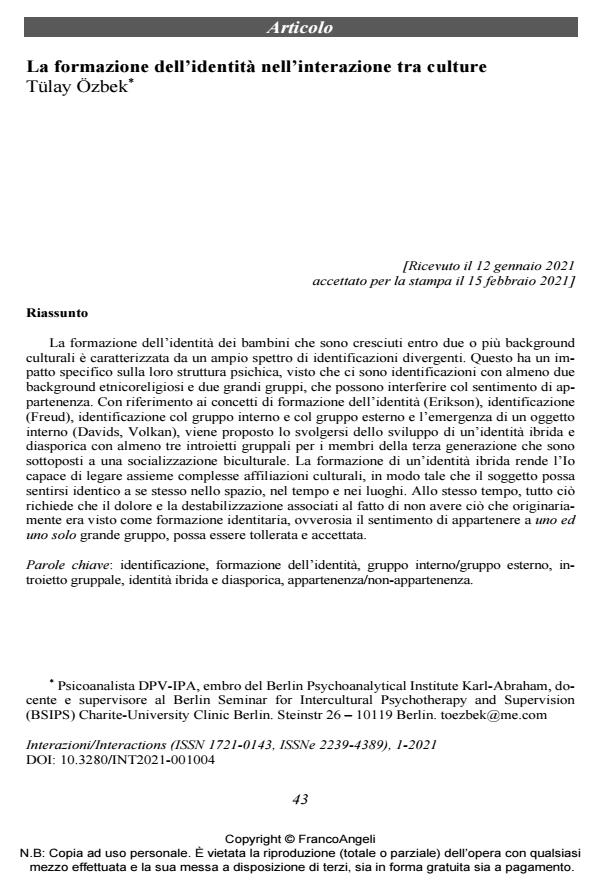La formazione dell’identità nell’interazione tra culture
Titolo Rivista INTERAZIONI
Autori/Curatori Tülay Özbek
Anno di pubblicazione 2021 Fascicolo 2021/1 Lingua Italiano
Numero pagine 16 P. 43-58 Dimensione file 197 KB
DOI 10.3280/INT2021-001004
Il DOI è il codice a barre della proprietà intellettuale: per saperne di più
clicca qui
Qui sotto puoi vedere in anteprima la prima pagina di questo articolo.
Se questo articolo ti interessa, lo puoi acquistare (e scaricare in formato pdf) seguendo le facili indicazioni per acquistare il download credit. Acquista Download Credits per scaricare questo Articolo in formato PDF

FrancoAngeli è membro della Publishers International Linking Association, Inc (PILA)associazione indipendente e non profit per facilitare (attraverso i servizi tecnologici implementati da CrossRef.org) l’accesso degli studiosi ai contenuti digitali nelle pubblicazioni professionali e scientifiche
La formazione dell’identità dei bambini che sono cresciuti entro due o più background cul-turali è caratterizzata da un ampio spettro di identificazioni divergenti. Questo ha un impatto specifico sulla loro struttura psichica, visto che ci sono identificazioni con almeno due back-ground etnicoreligiosi e due grandi gruppi, che possono interferire col sentimento di apparte-nenza. Con riferimento ai concetti di formazione dell’identità (Erikson), identificazione (Freud), identificazione col gruppo interno e col gruppo esterno e l’emergenza di un oggetto interno (Davids, Volkan), viene proposto lo svolgersi dello sviluppo di un’identità ibrida e diasporica con almeno tre introietti gruppali per i membri della terza generazione che sono sot-toposti a una socializzazione biculturale. La formazione di un’identità ibrida rende l’Io capace di legare assieme complesse affiliazioni culturali, in modo tale che il soggetto possa sentirsi identico a se stesso nello spazio, nel tempo e nei luoghi. Allo stesso tempo, tutto ciò richiede che il dolore e la destabilizzazione associati al fatto di non avere ciò che originariamente era visto come formazione identitaria, ovverosia il sentimento di appartenere a uno ed uno solo grande gruppo, possa essere tollerata e accettata.;
Keywords:Identificazione, formazione dell’identità, gruppo interno/gruppo esterno, in-troietto gruppale, identità ibrida e diasporica, appartenenza/non-appartenenza.
- Blum H.P. (1986). On Identification and its vicissitudes. International Journal of Psycho-Analysis, 67: 267-276.
- Davids F. (2011). Internal Racism. A Psychoanalytic Approach to Race and Difference. London: Palgrave Macmillan.
- Eickhoff F. (2011). Ein Plädoyer für das umstrittene Konzept der primären Identifizierung. Psyche – Zeitschrift für Psychoanalyse, 65, 1: 63-83.
- Etchegoyen H. (1985). Identification and its vicissitudes. International Journal of Psycho-Analysis, 66: 3-18.
- Erdheim M. (1992). Das Eigene und das Fremde. Über ethnische Identität. Psyche – Zeitschrift für Psychoanalyse, 46, 8: 730-742.
- Erikson E.H. (1956). The Problem of Ego Identity. Journal of the American Psychoanalytic Association, 4, 1: 56-121.
- Freud S. (1913). Totem e tabù. OSF, vol. 7. Torino: Bollati Boringhieri.
- Freud S. (1921). Psicologia delle masse e analisi dell’Io. OSF, vol. 9. Torino: Bollati Boringhieri.
- Freud S. (1923). L’Io e l’Es. OSF, vol. 9. Torino: Bollati Boringhieri.
- Freud S. (1925). Autobiografia. OSF, vol. 10. Torino: Bollati Boringhieri.
- Freud S. (1926). Discorso ai membri dell’Associazione B'Nai B'Rith. OSF, vol. 10. Torino: Bollati Boringhieri.
- Gezer Ö. (2013, November 4). Türkisiert [Turkeyfied]. Der Spiegel, 45. Retrieved January 9, 2016, from -- http://www.spiegel.de/spiegel/print/d-119402601.html
- Kaës R. (2009). Innere Gruppen und psychische Gruppalität: Entstehung und Hintergründe eines Konzepts. Psyche – Zeitschrift für Psychoanalyse, 63, 3: 281-305.
- Kazim H. (2010, December 24). Integrationsdebatte: Sarrazins Sünden ‒ böcke [Debate on integration: Sarrazin’s scapegoat]. Der Spiegel Online. Retrieved June 3, 2014, -- from http://www.spiegel.de/politik/deutsch-land/integrationsdebatte-sarrazins-suendenboecke-a-735774.html
- Langhoff S. (2008). -- http://www.bpb.de/gesellschaft/bildung/kulturelle-bildung/60135/interview-mit-shermin-langhoff?p=all. Zugriff 20.09.2019.
- Mayer R. (2005). Diaspora. Eine kritische Begriffsbestimmung. Bielefeld: transcript Verlag.
- Özbek T. (2012). Und es gibt sie doch die pakistanischen Cowboys ‒ Überlegungen zur hybriden Identitätsentwicklung. In Reiser-Mumme U., v. Tippelskich-Eissing D., Teising M., Walker C.E. (Hg.), Spaltung: Entwicklung und Stillstand. Frühjahrstagung der DPV. Frankfurt: Geber & Reusch.
- Özbek T. (2017). Living in Germany as a Kanak: Some Thoughts About Nonbelonging. Psychoanalytic Review, 104, 6: 707-721.
- Özbek T. (2020) (in press). The tale of those who went forth: On the inner experience of migration and forced migration. In White C., Klingenberg I. (Eds.), Migration and Inter-cultural Psychoanalysis: Unconscious Forces and Clinical Issues. London: Karnac Books.
- Simenauer E. (1985). Identification in the Theory and Technique of Psychoanalysis. Some Thoughts on its Farther Reaches and Functions. International Journal of Psycho-Analysis, 66: 171-184.
- Simsek S. (2012). Transkript eines Teils von Semiya Simseks Ansprache bei der Gedenkfeier zu den Opfern rechtsextremistischer Gewalt. Gamze Kubasik und Semiya Simsek erinnern an ihre ermordeten Väter/ -- www.youtube.com/watch?v=ra_NWRKRY-4–Zugriff 04.05.2012.
- Volkan V. (1999). Das Versagen der Diplomatie: Zur Psychoanalyse nationaler, ethnischer und religiöser Konflikte [The failure of diplomacy: The psycho-analysis of national, ethnic, and religious conflicts]. Gießen, Germany: Psychosozial, 2000.
- Volkan V. (2005). Blindes Vertrauen: Großgruppen und ihre Führer in Zeiten der Krise und des Terrors [Blind trust: Large groups and their leaders in times of crisis and terror]. Gießen, Germany: Psychosozial
Tülay Özbek, La formazione dell’identità nell’interazione tra culture in "INTERAZIONI" 1/2021, pp 43-58, DOI: 10.3280/INT2021-001004